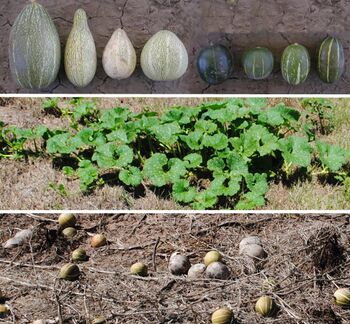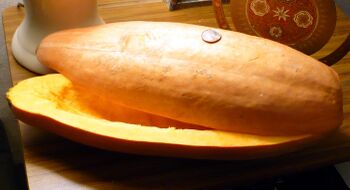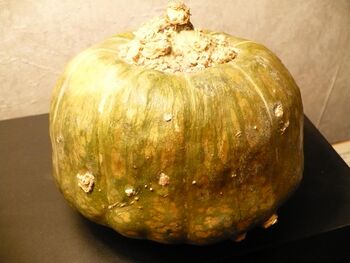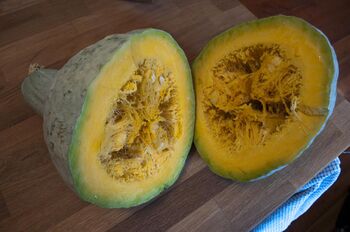Biology:Cucurbita maxima
| Cucurbita maxima | |
|---|---|

| |
| Scientific classification | |
| Kingdom: | Plantae |
| Clade: | Tracheophytes |
| Clade: | Angiosperms |
| Clade: | Eudicots |
| Clade: | Rosids |
| Order: | Cucurbitales |
| Family: | Cucurbitaceae |
| Genus: | Cucurbita |
| Species: | C. maxima
|
| Binomial name | |
| Cucurbita maxima Duchesne
| |
| Subspecies | |
| |
| Synonyms[1] | |
| |
Cucurbita maxima, one of at least five species of cultivated squash, is one of the most diverse domesticated species.[2] This species originated in South America from the wild subspecies Cucurbita maxima subsp. andreana over 4,000 years ago.[3] Cucurbita maxima, known for modern varieties as Hubbard, Delicious, Marblehead, Boston Marrow, and Turks Turban, originated in northern Argentina near the Andes or in certain Andean valleys.[4] Secondary centers of diversity include India , Bangladesh, Myanmar, and the southern Appalachians.
Different squash types of this species were introduced into North America as early as the 16th century. By the American Revolution, the species was in cultivation by Native American tribes throughout the present-day United States. By the early 19th century, at least three varieties are known to have been commercially introduced in North America from seeds obtained from Native Americans.[5]
Types
Subspecies andreana


At one time considered a separate species, andreana has been placed by modern biosystematics as a subspecies of C. maxima. It is native to Argentina and Uruguay and is the ancestor of the domesticated forms. C. andreana fruits are smaller and not palatable.[5][3] It hybridizes readily with individuals of other C. maxima subspecies.
C. maxima subsp. andreana has notably different calcium levels than individuals of other C. maxima subspecies.[7] C. andreana has yellow flowers and bright green striped fruit. Extrafloral nectaries are present in C. maxima but not necessarily in C. andreana.[8]
It was first formally described by Charles Victor Naudin in 1896, in Revue Horticole.[9]
Cultivars



- Arikara squash weighs from four to eleven pounds with a teardrop or round shape with a mottled orange and green color pattern. It is used both for its eating qualities and as decoration. This variety traces its ancestry to the Arikara tribe of the Dakotas, among whom its cultivation predates white settlement.[citation needed]
- Banana squash has an elongated shape, with light blue, pink, or orange skin and bright orange flesh.
- Boston marrow is sweet, narrow at one end, and bulbous at the other.[10]
- Buttercup squash has a turban shape (a flattish top) and dark green skin, weighs three to five pounds, and features dense, yellow-orange flesh. Not to be confused with butternut squash.
- Candy roaster squash is a landrace developed by the Cherokee people in the southern Appalachians. A United States Department of Agriculture accession in 1960 notes that Candy Roasters had been grown for more than 100 years as of that date.[11] It is variable in size and shape with more than 40 distinct forms according to one authority.[12] Candy roasters consistently feature fine-textured orange flesh, while varying in size (from 10 lbs to more than 250 lbs); shape (including round, cylindrical, teardrop, and blocky); and color (pink, tan, green, blue, gray, and orange).[13] An article in the 1925 Charlotte Observer newspaper of Charlotte, North Carolina provides an account of two candy roaster varieties at a Cherokee fair that were both of similar shape and size to a Catawba watermelon, one being colored like a citron melon and the other "pumpkin color".[14]
- Hubbard squash usually has a tear-drop shape and is often used as a replacement for pumpkins in cooking. According to one source,[15] the name comes from Bela Hubbard, settler of Randolph Township, Ohio, in the Connecticut Western Reserve. Other sources conclude that this variety came to Marblehead, Massachusetts via Captain Knott Martin where Elizabeth Hubbard brought it to the attention of her neighbor, a seed trader named James J. H. Gregory. Gregory subsequently introduced it to the market using Hubbard as the eponym. Gregory later bred and released the Blue Hubbard, a variety with bluish-gray skin. Another variety, the Golden Hubbard, has a bright orange skin. Gregory advertisements for Hubbard squash began by 1859.[16][17][18] The Hubbard squash, including questions regarding the name, is the subject of a children's ditty, "Raising Hubbard Squash in Vermont".[19]
- Jarrahdale pumpkin is a pumpkin with gray skin that is nearly identical to Queensland Blue and Sweet Meat (squash) varieties.
- Kabocha is a Japanese variety with dark green skin and bright golden-orange flesh.
- Lakota squash is an American variety.
- Nanticoke squash was grown by the Nanticoke people of Delaware and Eastern Maryland. It is one of only a few surviving Native American winter squashes from the Eastern woodlands.[20]
- Turban squash, also known as "French turban", predates 1820 and is closely related to the buttercup squash.[21]
Uses
Buttercup squash, a common cultivar, can be roasted, baked, and mashed into soups, among a variety of filler uses, much like pumpkin. It is extremely popular, especially as a soup, in Brazil , Colombia, and Africa.
All giant pumpkins (over 300 pounds or 140 kilograms) are of this species, including the largest pumpkins ever documented, which have attained a size of 2,702.9 pounds (1,226.0 kg) (As of 2021).[22]
The seed of C. maxima is used in treating parasites in animals.[23]
Cultivation
Since this plant requires a fair amount of hot weather for best growth, it has not become very well established in northern Europe, the British Isles, or in similar areas with short or cool summers.[4]
The ideal soil pH range for cultivation ranges from 6.0 to 6.8.
Recommended spacing can vary depending on the specific variety, but generally, plants are spaced around 3–5 feet apart in rows that are approximately 6–10 feet apart. Planting depth of around 1–2 inches.
Fertilization should be carried out based on soil test results and specific crop nutrient requirements.[24]
Many cultivars of Cucurbita maxima have been developed. Only long-vining plants are known in this species.[4] As in C. pepo, plants exist with a "bush habit" that is particularly evident in young plants, but older plants grow in the wild-type vining manner.[25]
Gallery
-
Typical "Zapallito" summer squash fruit.
-
A vining cultivar growing up to a roof.
References
- ↑ "Cucurbita maxima". The Plant List. http://www.theplantlist.org/tpl/record/kew-2747160.
- ↑ Ferriol, María; Picó, Belén; Nuez, Fernando (2004). "Morphological and Molecular Diversity of a Collection of Cucurbita maxima Landraces". Journal of the American Society for Horticultural Science 129 (1): 60–69. doi:10.21273/JASHS.129.1.0060.
- ↑ 3.0 3.1 Sanjur, Oris I.; Piperno, Dolores R.; Andres, Thomas C.; Wessel-Beaver, Linda (2002). "Phylogenetic Relationships among Domesticated and Wild Species of Cucurbita (Cucurbitaceae) Inferred from a Mitochondrial Gene: Implications for Crop Plant Evolution and Areas of Origin". Proceedings of the National Academy of Sciences of the United States of America (Washington, DC: National Academy of Sciences) 99 (1): 535–540. doi:10.1073/pnas.012577299. PMID 11782554. PMC 117595. Bibcode: 2002PNAS...99..535S. http://www.pnas.org/content/99/1/535.full.pdf.
- ↑ 4.0 4.1 4.2 Victor E. Boswell and Else Bostelmann. "Our Vegetable Travelers." The National Geographic Magazine. 96.2: August 1949.
- ↑ 5.0 5.1 Nee, Michael (1990). "The Domestication of Cucurbita (Cucurbitaceae)". Economic Botany (New York: New York Botanical Gardens Press) 44 (3, Supplement: New Perspectives on the Origin and Evolution of New World Domesticated Plants): 56–68. doi:10.1007/BF02860475.
- ↑ Millán, R. (1945). "Variaciones del zapallito amargo Cucurbita andreana y el origen de Cucurbita maxima" (in es). Revista Argentina de Agronomía 12: 86–93.
- ↑ Skilnyk, Hilary R.; Lott, John N. A. (1992). "Mineral analyses of storage reserves of Cucurbita maxima and Cucurbita andreana pollen". Canadian Journal of Botany 70 (3): 491–495. doi:10.1139/b92-063.
- ↑ López-Anido, Fernando; Vesprini, José (2007). "Extrafloral Nectaries in Cucurbita maxima Sub. andreana (Naudin) Filov". Cucurbit Genetics Cooperative Report (Raleigh, NC: North Carolina State University) 30: 38–42. http://cuke.hort.ncsu.edu/cgc/cgc30/2007toc.html.
- ↑ {{citation | mode = cs1 | title = Cucurbita maxima | work = Germplasm Resources Information Network (GRIN) | url = | publisher = [[Organization:Agricultural Research ServAgricultural Research Service (ARS), United States Department of Agriculture (USDA) | access-date = September 10, 2013 }}
- ↑ "Boston Marrow Squash". Rare Seeds. http://www.rareseeds.com/boston-marrow-s/.
- ↑ Plant Inventory No. 168. United States Department of Agriculture. 1967. http://archive.org/details/plantinventory168170agri.
- ↑ Best, Bill (2013-04-15) (in en). Saving Seeds, Preserving Taste: Heirloom Seed Savers in Appalachia. Ohio University Press. ISBN 978-0-8214-4462-7. https://books.google.com/books?id=D-RlrT8gQJIC.
- ↑ Dwivedi, Sangam; Goldman, Irwin; Ortiz, Rodomiro (August 2019). "Pursuing the Potential of Heirloom Cultivars to Improve Adaptation, Nutritional, and Culinary Features of Food Crops" (in en). Agronomy 9 (8): 441. doi:10.3390/agronomy9080441. ISSN 2073-4395.
- ↑ "The Candy Roaster". The Charlotte Observer: pp. 8. October 31, 1925. https://charlotteobserver.newspapers.com/image/616615490/?terms=the%20candy%20roaster&match=1.
- ↑ Troyer, Loris C. (1998). Portage Pathways. Kent, OH: Kent State University Press. p. 8. ISBN 978-0-87338-600-5.
- ↑ Watson, Ben (1996). Taylor's Guides to Heirloom Vegetables: A Complete Guide to the Best Historic and Ethnic Varieties. Boston: Houghton Mifflin Harcour. p. 268. ISBN 978-0-395-70818-7. https://archive.org/details/taylorsguidetohe00benj/page/268.
- ↑ "James J. H.Gregory: A Timeline of his Life". SaveSeeds.org. http://www.saveseeds.org/biography/gregory/index.html.
- ↑ Downing, Andrew Jackson (May 1859). The Horticulturalist, and Journal of Rural Art and Rural Taste. 14. New York: C. M. Saxton, Barker & Co.. p. 4. https://books.google.com/books?id=BpQAAAAAYAAJ&q=Hubbard+Squash&pg=RA6-PA4.
- ↑ Cady, Daniel Leavens (1919). Rhymes of Vermont Rural Life. Rutland, VT: The Tuttle Company. p. 100. https://books.google.com/books?id=h0tFAAAAIAAJ&q=Hubbard+Squash&pg=PA100.
- ↑ "Nanticoke Squash" (in en). https://store.experimentalfarmnetwork.org/products/nanticoke-squash.
- ↑ "What Is Turban Squash and How Is It Used?" (in en). https://www.thespruceeats.com/what-is-turban-squash-5199213.
- ↑ "Guinness World Record Pumpkins". gpc1.org. https://gpc1.org/gpc-champions/guinness-records/guinness-pumpkins/.
- ↑ Díaz, Obregón D.; Lloja, Lozano L.; Carbajal, Zúñiga V. (2004). "Preclinical studies of cucurbita maxima (pumpkin seeds) a traditional intestinal antiparasitic in rural urban areas" (in es). Revista de Gastroenterologia del Perú 24 (4): 323–327. PMID 15614300.
- ↑ "How to Grow and Care for Winter Squash" (in en). https://www.thespruce.com/cucurbita-maxima-winter-squash-guide-5201845.
- ↑ Mark G. Hutton and R. W. Robinson. "Gene List for Cucurbita spp.". http://cuke.hort.ncsu.edu/cgc/cgcgenes/gene92squash.html.
External links
Wikidata ☰ Q161180 entry
 |



